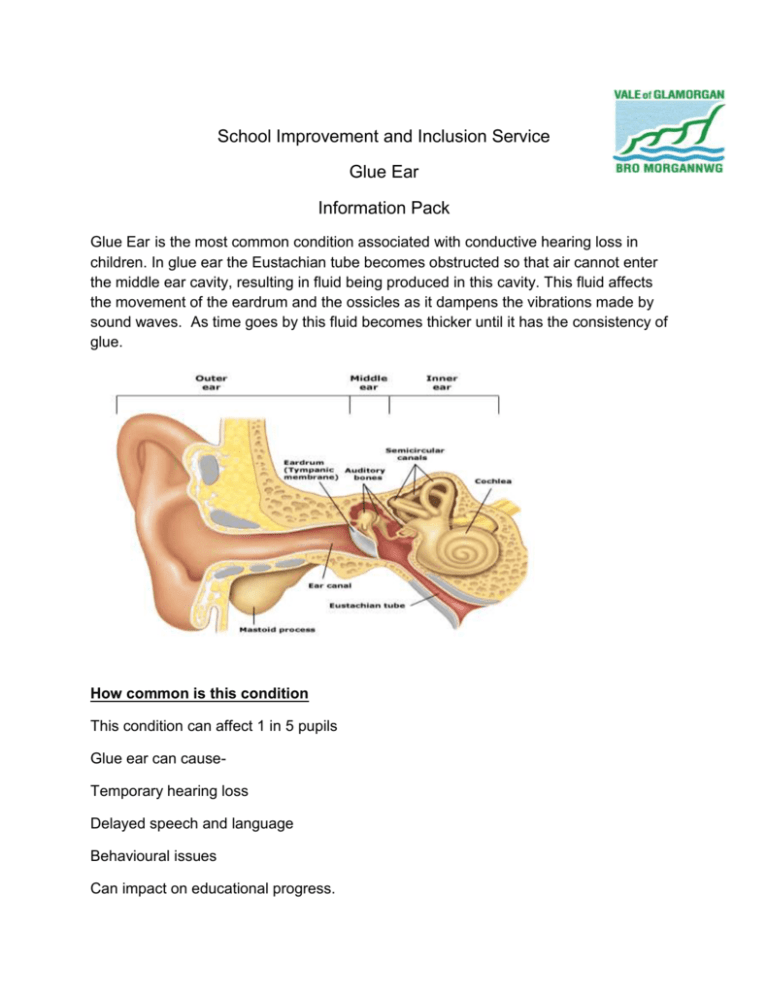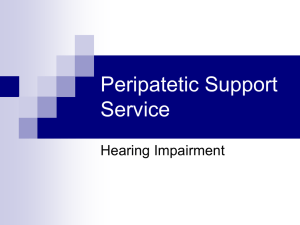Glue-Ear-Information-Pack - Vale of Glamorgan Council
advertisement

School Improvement and Inclusion Service Glue Ear Information Pack Glue Ear is the most common condition associated with conductive hearing loss in children. In glue ear the Eustachian tube becomes obstructed so that air cannot enter the middle ear cavity, resulting in fluid being produced in this cavity. This fluid affects the movement of the eardrum and the ossicles as it dampens the vibrations made by sound waves. As time goes by this fluid becomes thicker until it has the consistency of glue. How common is this condition This condition can affect 1 in 5 pupils Glue ear can causeTemporary hearing loss Delayed speech and language Behavioural issues Can impact on educational progress. Glue ear can be for some children a short term, fluctuating and / or a persistent condition. Usually children grow out of the condition by the age of 7-8 as the eustachian tube widens resulting in better drainage of the middle ear. Glue ear can however persist for some children into secondary school and with other groups of children such as children with Down’s syndrome. Glue ear has been described as listening to the TV with the sound turned too low or trying to hold a conversation in a noisy room. http://www.betterhearing.org/hearing_loss/hearing_loss_simulator/ gives an example of what it is like to hear if you have mild – moderate hearing loss. Effects of Glue Ear A pupil may: Appear dreamy, disruptive, distracted or demanding Find it difficult to listen and hear quiet speech Be withdrawn and wait for cues from others in the class Give the impression of being able to listen when s/he wants too. Find it difficult to hear when there is background noise Not hear clearly in a group situation Have unclear speech Have a vocabulary delay Have delayed language and social skills Be experiencing difficulties acquiring phonics / spellings. What can the teacher do? Before speaking attract pupil’s attention. Face the pupil as much as possible. Ensure keywords, topic headings and questions are visible. Use as much visual material as possible. Position pupils so that their backs are to any windows to facilitate lip reading. Speak clearly in a normal voice, maintaining a normal rhythm facing the pupil. Limiting your mobility around the classroom will give a consistent sound level. Check that instructions are understood. Repeat / record responses from other pupils. Repeat, rephrase, explain, simplify and clarify. Keep noise levels to a minimum - soft furnishings, cushions, blinds and corkboards all help to absorb sound creating a better acoustic environment. Allow the pupil to work in quiet areas. What can the pupil do Encourage the pupil to:Ask for repetitions and explanations. Sit in an appropriate place, such as the middle of the room facing the teacher. Listen carefully. Curricular Considerations Phonics ~ can cause particular concern when sounds are similar, such as f/v, t/d, p/b and c/g – use visual cues such as jolly phonics actions Spelling Tests ~ discrimination between single words can be difficult, so spelling should be put in to sentences to provide further clues / meaning. Mental Arithmetic ~ hearing difficulties between numbers for example six and sixteen use worksheets / flashcards if appropriate. Vocabulary ~ use known vocabulary to explain new vocabulary. Action intervention If you suspect that a child has a hearing loss Inform parents a GP referral will need to be made to have a hearing test usually in a community clinic. If a hearing loss is diagnosed, a permanent loss (sensori neural loss) then the pupil will be referred to the hospital – audiology department. If a conductive loss is diagnosed, depending on the degree of loss this will either be monitored at the local clinic or the pupil will be referred to the local hospital – audiology / ENT department for hearing aids / grommet insertion. Autoinflation / Otovent- This is a technique in which a child blows up a special balloon using their nose and not their mouth. The purpose is to force open the Eustachian tube and to allow pressure in the middle ear to return to normal allowing fluid in the middle ear to drain away – details are on the NDCS website. Pupils who have glue ear usually with appropriate management are able to access the curriculum. If there are any further issues then please contact the Service on 01446 709180 Useful website www.ndcs.org.uk Action on Hearing Loss website NDCS - Phone Free phone Helpline 0808 800 8880 for information booklets on deafness. GlueEarInformatin





